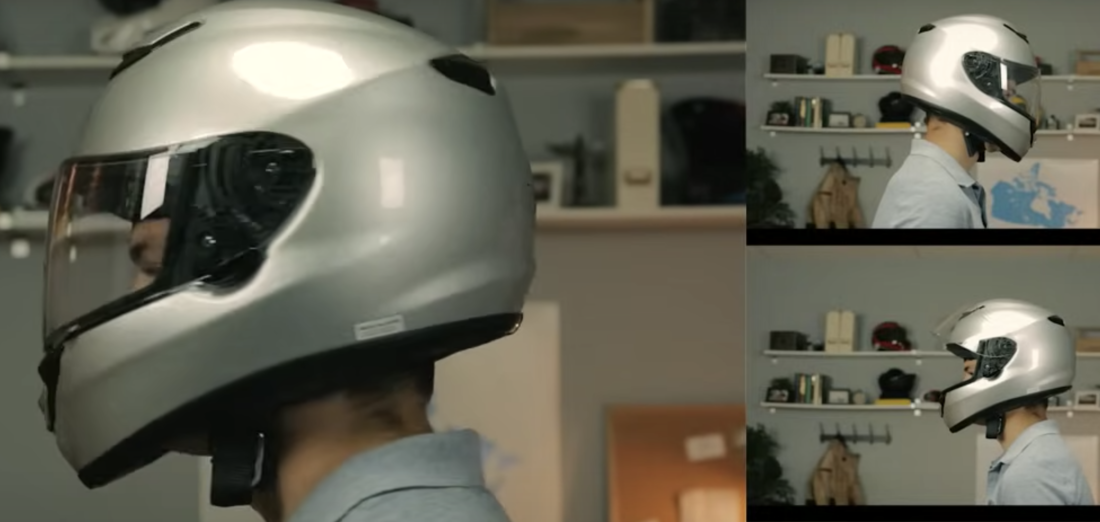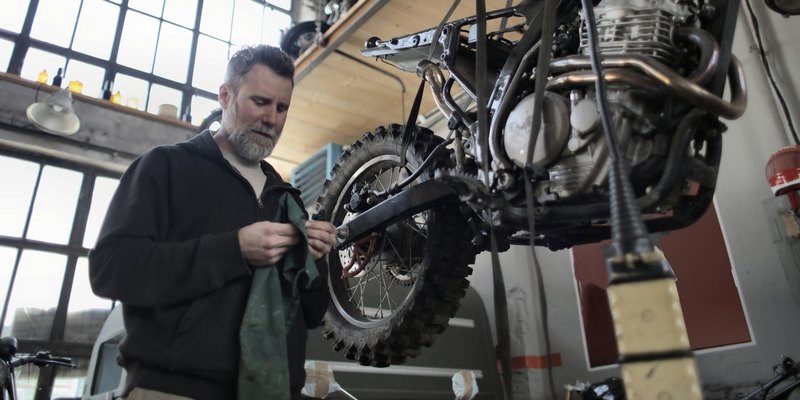Silence on Two Wheels with the Quietest Motorcycle Helmet

On extended motorcycle journeys, the narrator has a penchant for immersing themselves in audiobooks. However, they’ve encountered a common issue – the disruptive wind noise that permeates most helmets while cruising at highway speeds. Consequently, they’ve invested a considerable amount of time searching for the most noise-reducing motorcycle helmets available. Here are their top five picks.
Shoei RF-1400 Helmet
The Shoei RF-1400 helmet not only embraces style but also prioritizes safety. It adheres to SNELL M2020 safety standards, ensuring top-notch protection, and offers advanced ventilation alongside four different shell sizes to guarantee a snug fit.

Quietest Open-Face Helmet
This open-face helmet blends comfort with minimal noise intrusion. Its intricate, multi-layered interior construction ensures a secure and tranquil riding experience.
Shoei RF-1400
Shoei’s reputation for crafting exceptionally quiet helmets is upheld by the RF-1400. It boasts an aerodynamic shell that reduces drag and lift, surpassing its predecessor, the RF-1200, in terms of noise reduction. The design team addressed wind noise with enhanced windproof and waterproof seals, amplified cheek pads for noise dampening, and a shield system using vortex technology to deflect wind.
Additionally, the RF-1400 meets both SNELL M2020 and DOT safety requirements. Its extensive ventilation ensures comfort in various weather conditions, and the removable interior allows for easy cleaning.
Pros:
- Cutting-edge aerodynamic design
- Effective windproof sealing
- Noise-dampening, removable interior
- SNELL M2020 certified
- Comprehensive ventilation
Cons:
- Heavier than some other models
- Slightly different fit compared to previous Shoei models
Schuberth C5
The Schuberth C5 builds upon the quiet legacy of its predecessor, the C4. A noise-dampening interior and aerodynamic design contribute to its serene ride. It also features a spoiler for reduced buffeting and fatigue during long highway journeys.
Remarkably, the C5 boasts a nearly silent ventilation system, an unusual trait in quiet helmets. Furthermore, it comes equipped with pre-installed speakers, perfect for communication systems or enjoying music and GPS navigation.
Pros:
- Noise-reducing interior
- Aerodynamic anti-fatigue design
- Quiet ventilation
- Pre-installed speakers
- Safe EPS foam shell
Cons:
- Slightly heavier
- Limited color options
HJC RPHA 70 ST
HJC helmets offer excellent value, and the RPHA 70 ST is no exception. It features a lightweight carbon fiber and carbon-glass shell that absorbs impact effectively. The helmet’s aerodynamic shape minimizes wind noise and buffeting at high speeds.
The ventilation system, with top-side vents, ensures rider comfort on long journeys. However, it’s worth noting that the helmet’s finish is available in limited colors and is prone to scratching more easily than others.
Pros:
- Exceptional value
- Lightweight carbon shell
- Moisture-wicking interior
- Effective noise sealing
- Top-side ventilation
Cons:
- Limited color choices
- Prone to finish chipping
Sedici Strada II Mips
For budget-conscious riders seeking noise reduction on highways, the Sedici Strada II offers an attractive option. This helmet minimizes wind noise through a seamless face shield gasket and a removable wind skirt. Its Kevlar shell and aerodynamic shape further enhance wind management.
The ventilation system, with adjustable vents at the chin and crown, ensures comfort and temperature control during rides.
Pros:
- Affordable price
- Seamless face shield gasket
- Sturdy Kevlar shell
- Streamlined aerodynamics
- Effective ventilation
Cons:
- Limited color choices
- Prominent visor switch
Shoei J-Cruise II
Open-face helmets typically aren’t associated with quietness, but the Shoei J-Cruise II aims to change that perception. While not as quiet as full-face helmets, its multi-piece EPS liner promotes smoother airflow, and the dense, five-layered interior provides some noise protection. Additionally, riders can enjoy the sensation of wind on their face, ideal for hot weather.
Pros:
- Comfortable open-face design
- Multi-piece EPS liner
- Five-layer cheek pads
- Removable interior
- Built-in sun shield
Cons:
- Louder than full-face helmets
- Slightly heavy for an open-face model
Factors Affecting Helmet Quietness
Neck Opening
Wind noise primarily enters the helmet through the bottom and resonates inside, creating an unwanted auditory disturbance for the rider. This phenomenon occurs because the wind rushes past the lower edge of the helmet, gaining access to the interior. Once inside, it reverberates, creating a cacophony that can be both distracting and fatiguing.
To mitigate this issue and enhance the overall quietness of a helmet, the inclusion of a neck skirt is essential. This vital component forms a barrier, sealing the lower portion of the helmet to the rider’s neck and effectively preventing wind from infiltrating the interior. By closing off this entry point, the neck skirt significantly reduces the amount of wind noise that can penetrate the helmet.
By focusing on this aspect of design, helmet manufacturers can greatly enhance the riding experience, allowing motorcyclists to enjoy a quieter and more comfortable journey. The implementation of a neck skirt not only promotes a serene atmosphere within the helmet but also contributes to improved rider concentration, safety, and overall ride quality.
Fit
Proper helmet fit is crucial for noise reduction. It should snugly fit without excessive movement, especially at high speeds, to prevent wind intrusion.
Helmet Seams
Seams in a helmet, while necessary for construction, have the potential to create an unintended problem – the intrusion of air and noise. These seams, where different parts of the helmet are joined, can inadvertently allow wind to penetrate, leading to increased noise levels within the helmet. This can be both distracting and discomforting for the rider, compromising the overall riding experience.
To address this issue, helmet manufacturers employ various strategies to reduce the impact of seams on noise levels. One common approach is the use of windproof seams or single-piece gaskets. Windproof seams are designed to minimize the gaps between helmet components, preventing air from entering and, consequently, reducing noise. Single-piece gaskets are integrated into the helmet’s construction to create a continuous seal, effectively sealing off potential entry points for air and noise.
By adopting these techniques, helmet manufacturers enhance the quietness of their products, allowing riders to enjoy a more peaceful and focused journey. These measures not only contribute to noise reduction but also underscore the commitment of manufacturers to providing riders with a superior and enjoyable riding experience.
Aerodynamic Shape
A helmet’s aerodynamic design plays a pivotal role in determining its noise level during rides. The shape of the helmet directly impacts how it interacts with the rushing wind, and this interaction can either enhance or reduce the noise experienced by the rider.
- Helmets with sleek and aerodynamic designs are engineered to minimize wind buffeting, which in turn significantly reduces noise. When the helmet’s exterior is crafted with attention to aerodynamics, it allows the wind to smoothly flow over the surface. This streamlined airflow avoids creating turbulent pockets of air that can generate noise as it collides with the helmet’s various contours.
- In contrast, helmets with less aerodynamic shapes tend to experience more turbulence, leading to increased wind noise. The buffeting caused by irregular shapes can be not only distracting but also physically fatiguing for the rider during prolonged journeys.
Therefore, when choosing a helmet with a quieter ride in mind, considering its aerodynamic design is crucial. A well-designed, sleek helmet not only enhances the rider’s comfort but also promotes a safer and more enjoyable experience by minimizing the distracting effects of wind noise.
Ventilation Design
While ventilation is necessary, it can introduce noise. Well-designed ventilation channels can minimize air turbulence and noise.
Don’t Forget About Safety
While prioritizing noise reduction in motorcycle helmets is essential for rider comfort, it must not come at the expense of safety. Safety remains the paramount concern when it comes to protective headgear for motorcyclists.
Helmets should adhere to, at the very least, the safety standards set by the Department of Transportation (DOT). These standards ensure that a helmet provides a minimum level of protection, including impact resistance and penetration protection. It’s the foundation of safety that every helmet should meet to be considered roadworthy.
Final Thoughts
Reducing wind noise enhances both safety and comfort during rides. It’s not just about enjoying a peaceful journey; it also contributes significantly to overall rider well-being.
- Safety is paramount when riding a motorcycle, and a quiet helmet plays a crucial role in this regard. Excessive noise within a helmet can lead to distraction and fatigue, impairing a rider’s ability to focus on the road and surrounding traffic. This distraction can increase the risk of accidents and compromise the rider’s reaction time to unexpected situations. In contrast, a quiet helmet minimizes distractions, allowing the rider to maintain full concentration on their surroundings and potential hazards.
- Moreover, a quieter helmet can help prevent hearing damage caused by prolonged exposure to wind and engine noise. Constant exposure to high-decibel noise levels can lead to long-term hearing impairment, making noise reduction a safety feature in its own right. The Shoei RF-1400, known for its exceptional noise reduction, not only enhances safety by minimizing distractions but also protects the rider’s hearing, making it an ideal choice for those who prioritize safety above all else.
- In addition to safety, comfort is paramount during long rides. Wind noise can be physically and mentally exhausting, causing rider fatigue. A quiet helmet ensures that riders can travel longer distances without becoming physically and mentally drained, resulting in a more enjoyable and less tiring journey.
For those who prefer the freedom of open-face helmets, the Shoei J-Cruise II offers a quieter alternative without sacrificing comfort and safety. In conclusion, prioritizing a quiet helmet is not just about enjoying a peaceful ride; it is a crucial element for enhancing safety and rider comfort, ensuring a safer and more enjoyable journey for motorcycle enthusiasts.
